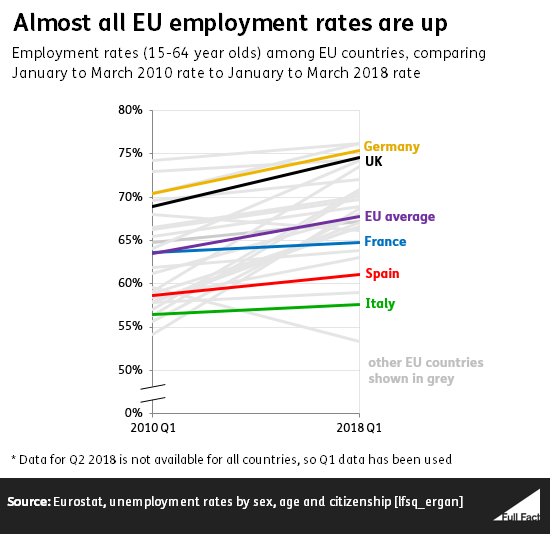“Since 2010, we’ve created more jobs than than [sic] France, Spain, Ireland, The Netherlands, Austria, Sweden and Norway combined.”
Conservative party, 1 October 2018
The claim is correct if you compare the number of people in jobs during the first quarter of 2010 with the first quarter of 2018. Over that period the number of employed people aged 15 and over increased by about 3.4 million in the UK and by 3.3 million in those other European countries combined
These figures look at the number of people in work, rather than the number of jobs available (as people can have more than one job).
More recent data for the second quarter of 2018 is available for most of these countries (with the exception of Ireland). Based on these figures it looks very unlikely that the claim will still be true comparing the second quarter of 2010 with 2018.
The employment rate (in this case, the percentage of people aged 15-64 in employment) is arguably a more helpful measure to use when looking at how the UK’s jobs market compares to other European countries.
 Since the first quarter of 2010, the UK’s employment rate has increased by almost six percentage points, slightly below the growth of both Sweden and Ireland, but above the other five countries mentioned in the claim.
Since the first quarter of 2010, the UK’s employment rate has increased by almost six percentage points, slightly below the growth of both Sweden and Ireland, but above the other five countries mentioned in the claim.
The growth in the UK’s employment rate ranks 12th out of the 28 EU countries—slightly above average, though the 16 countries the UK has outpaced include the large economies of Germany, France, Spain and Italy.
As of early 2018, the UK’s 75% employment rate ranked fourth in the EU, behind Sweden, the Netherlands and Germany.
Honesty in public debate matters
You can help us take action – and get our regular free email
Why are employment rates more helpful?
In theory, using the number of total people in employment to talk about the job market can be misleading. That’s why we think the employment rate is a better measure.
For example, if a country’s population was growing very quickly, it could be the case that both the number of people in employment and the number of people in unemployment were increasing at record rates.
Also comparing the growth in employment to other countries can be misleading. Countries are different sizes, and so the fact that say, one country’s added 100,000 jobs in a year while another has only added 50,000 might just tell you more about the size of those countries rather than their recent employment record.
Finally, making this comparison could make the employment situation seem rosier than it is. For example, the number of people in employment in a country could increase more quickly than other countries, but it could still have a lower percentage of people in work.
In the case of this specific claim, talking about the total increase in employment isn’t misleading—the UK’s employment rate has been increasing more quickly than most EU countries and all of the large economies in it, and the employment rate overall is close to the top of the pile. But by and large it is better to talk about employment rates rather than about the total number of people in work, in order to avoid these potential pitfalls.
 Since the first quarter of 2010, the UK’s
Since the first quarter of 2010, the UK’s